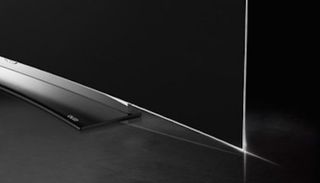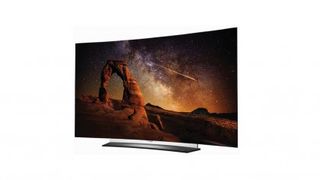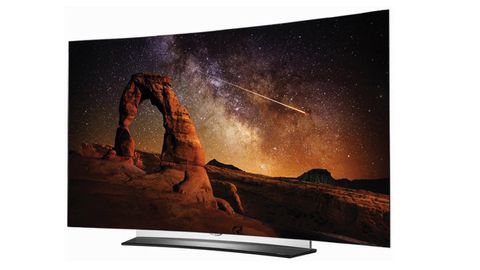Why you can trust TechRadar
The OLED55C6V is unquestionably the best OLED TV LG has made so far – which is saying something considering how many wow moments its predecessors have given us. That said, LG still has a few bits and bobs to sort out before OLED becomes 100% irresistible.
So that we can finish this section in the positive vein this TV deserves, let's get the negative stuff out of the way first – starting with the screen's occasional noise issues during dark scenes, and especially dark HDR scenes.
First up, HDR pictures can suffer from a peculiar effect whereby all the definition and light subtleties in the very darkest sections of the picture can go AWOL as they're taken over by a slightly blocky, vaguely glowing noise effect. Dark backdrops also occasionally fall prey to different dot-crawl noise that sometimes becomes noticeable enough to pull your eye away from the action.

Another issue to be wary of is that the OLED55C6V's pictures fall down quite severely if you're not pretty precise with its main brightness setting. Set it to less than its 49 level and details start to get noticeably crushed out of dark areas; push it higher than 52 and the screen's otherwise spellbinding black levels rapidly start to grey over.
The OLED55C6V's curved screen, meanwhile, can cause distracting distortions of any bright light sources opposite the screen, and LG's motion handling could do better; action scenes can look quite juddery if you turn off the OLED55C6V's TruMotion circuitry completely, yet all the TruMotion presets LG provides end up making pictures look rather processed, with flickering and haloing artefacts over or around fast-moving objects.
Fortunately you can get a satisfactory solution by selecting the Custom setting and then choosing values of either two or three for the judder and blur reduction components.
One last issue is some loss of detail in bright whites and the brightest areas of colour when watching HDR content. This is caused, presumably, by the OLED55C6V still not delivering enough brightness to cover the full brightness range of HDR content (its light output peaks at between 600 and 650 nits using any sensible picture settings, versus the 1000 nits most UHD Blu-rays are currently mastered to).
Right, that's quite enough miserableness. Let's get to the good stuff. Starting with the fact that, despite the occasional noise blemish with really extreme HDR content, the OLED55C6V's black level performance is just stunning. Not even the best LCD TV can get close to delivering the depth or, especially, the evenness, consistency and accuracy of black level response displayed by LG's OLED maestro.

This benefit of OLED's self-emissive pixel structure is particularly obvious and welcome when watching HDR content, as even the most intensely white tones or bright colours are able to sit just a pixel away from intense, deep black colours without even a hint of light 'contagion'.
Every LCD TV I've seen to date exhibits a degree of light haloing or striping around bright HDR objects when they appear against dark backdrops, with some screens having to severely compromise the black level response of the entire image when asked to deal with a bright object within a predominantly dark HDR shot.
The bottom line is that, except for the fortunately rare occasions where the noise discussed earlier creeps into proceedings, the OLED55C6V is the first TV I've tested that consistently delivers HDR scenes that look as convincing, immersive and flat-out beautiful as their creators doubtless dreamed they would.
Stellar colours
Good black levels usually prove an ideal foundation for good colours, and sure enough the OLED55C6V's spectacular blacks are partnered by fantastically vibrant, full-blooded colours more than capable of reproducing the extra image punch delivered by the wide colour gamuts sported by all UHD Blu-rays (so far) and a growing number of streamed video sources.
The way OLED pixels create their own light also means that, unlike with LCD TVs, you can watch the OLED55C6V from an extremely wide viewing angle without the image's contrast or colour reducing in intensity.

As noted earlier, even the extra brightness LG has conjured for its 2016 OLEDs can't stop the OLED55C6V from falling slightly short of the colour volume and subtle toning in the brightest HDR areas that you get with the best LCD TVs. But the OLED screen's infinitely more accurate light controls mean colour tones remain more consistent – at least during dark HDR scenes – than they do with LCDs, as they don't keep getting infiltrated by extraneous areas of greyness.
The extra brightness LG has found for its OLED TVs also means you get a more potent sense of HDR's peak brightness potential; in other words, it's not only in dark scenes that the OLED55C6V gets its HDR mojo on.
The OLED55C6V's considerable colour talents are especially obvious, interestingly, if you're watching Dolby Vision HDR. Dolby's metadata system, appreciation for the pros and cons of the screens it's working with and, I guess, huge experience in the cinema and home cinema worlds give clips of Pan in Dolby Vision which I had stored on a USB stick a strikingly richer but also subtler colour range than the same movie in its HDR10 Ultra HD Blu-ray incarnation – at least as rendered by LG's default (and best) Standard HDR mode.
Dolby Vision Differences
The more refined handling of colour and light in Dolby Vision mode also means DV sources look more detailed and three-dimensional than HDR10. It should be said that HDR10 playback looks much brighter on the LG than the Dolby Vision version; Dolby's system actually sets the TV's OLED brightness to just 50, while LG's HDR10 approach pushes OLED brightness to 100.
Some may be unable to resist the allure of all that extra HDR10 brightness, but my feeling is that most of the sort of video enthusiasts likely to buy the OLED55C6V will feel that Dolby Vision's approach simply proves that brightness is perhaps not the be-all and end-all of good HDR playback after all.

The precision of the OLED55C6V's colour and light handling helps it make the most of its Ultra HD resolution when fed a native 4K source too, except for where detail 'clipping' crops up in the brightest areas. In fact, its detailing is pretty much immaculate when you're watching standard dynamic range sources (which you will be most of the time), since the reduced brightness range of SDR content largely takes the brightness-related clipping issues out of the equation.
Pretty much everything is perfect about the TV's SDR performance, in fact, as the colour, contrast and brightness ranges introduced to boost HDR give the screen enough 'headroom' to handle SDR more or less effortlessly.

LG has provided an HDR Effect mode on the OLED55C6V, which attempts to expand the colour range and luminance of SDR images to give them an HDR feel. However, the processing seems much more enthusiastic about expanding the luminance range than it does the colour spectrum, resulting in a slightly anaemic look that made me feel more comfortable leaving standard dynamic range content playing in its native state.
Similarly, I'd advise against using the Vivid HDR10 setting LG provides on the OLED55C6V, for while this pushes brightness with HDR sources much more aggressively than the HDR Bright and HDR Standard settings, it also leaves colours looking unconvincing, reduces colour detail, and is much more likely to throw up video noise.
Gaming and 3D
Tests reveal that the OLED55C6V's screen takes only 30ms or so to render its images, making it one of the most responsive and therefore game-friendly UHD TVs around. I was struck right away by how relaxing its 3D images are, as its passive approach removes all flicker and most crosstalk ghosting noise.
The screen's stellar contrast plays an important role in delineating an exceptional sense of scale to the 3D worlds you're watching too, while the freedom from the shuttering effect of active glasses means 3D pictures look almost as bright and vibrant as 2D ones.
Usability
It's hard to think of any TV that could be easier to operate than the OLED55C6V. Its webOS 3.0 interface is joyously simple and straightforward, and runs slickly. The point-and-click remote works well too, once you get used to its quite extreme sensitivity.
The one thing that dents the OLED55C6V's usability credentials is the fact that you have to be careful with some of its picture settings if you don't want to have a seriously negative impact on what you're viewing.
Sound
The OLED55C6V sounds about average for a flat TV. Deep bass is pretty much restricted to a few distracting thuds and pops, which can lead to dense action scenes sounding a bit unbalanced and harsh from time to time.
The mid-range is reasonably open and clean, though, and both male and female voices sound pretty convincing, even under duress. The soundstage spreads quite nicely beyond the confines of the TV's bodywork too, without losing cohesion or sounding excessively thin and weedy.
Actually, even sounding average should probably be considered a success when you're talking about a TV that's as incredibly slim over much of its frame as the OLED55C6V is.
AV Technology Contributor
John has been writing about home entertainment technology for more than two decades - an especially impressive feat considering he still claims to only be 35 years old (yeah, right). In that time he’s reviewed hundreds if not thousands of TVs, projectors and speakers, and spent frankly far too long sitting by himself in a dark room.

AMD’s next-gen CPUs set to be Ryzen 9000 – and here’s another clue that Zen 5 launch could be imminent

'In the beginning I didn't want to – my son persuaded me': why Audiovector's Trapeze Reimagined speaker is a 45-year family affair

Report claims Vision Pro sales have ‘fallen sharply’ as Apple struggles to whip up demand

